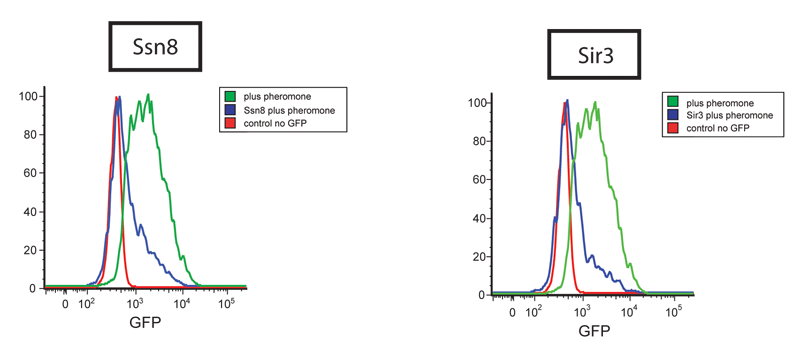Team:UCSF/Strengthening Silencing
From 2008.igem.org
| (4 intermediate revisions not shown) | |||
| Line 1: | Line 1: | ||
| + | '''Silencing in S. cerevisiae is thought to be limited by the cellular pool of Sir3''' (Hecht et al., 1996), and potentially by other factors. At the beginning of the summer, we conducted a small (20 gene), candidate-based screen for genes that, when overexpressed, enhance silencing. Overexpression of '''Sir3''' (but not Sir2) enhanced the function of a weakly silenced bit. Interestingly, '''Ssn8''' also strongly enhanced silencing. Ssn8 is a component of the RNA Polymerase II holoenzyme that interacts with mediator (we chose it because it is positively associated with Telomere maintenance). | ||
| + | '''We used this result to "push" the weakly silenced Fig1P reporter into a fully silenced state.''' In these experiments, LexA-Sir2 was constitutively expressed by the strong Adh1P promoter. The silencing enhancer was also driven by the Adh1 Promoter. | ||
| Line 5: | Line 7: | ||
| - | + | For more ambitious silencing applications, overexpression of these and other genes may be used to strengthen the power of heterochromatin. It may be useful to build a chassis strain for silencing where expression of these factors is optimized. | |
<!--- The Mission, Experiments ---> | <!--- The Mission, Experiments ---> | ||
Latest revision as of 02:45, 30 October 2008
Silencing in S. cerevisiae is thought to be limited by the cellular pool of Sir3 (Hecht et al., 1996), and potentially by other factors. At the beginning of the summer, we conducted a small (20 gene), candidate-based screen for genes that, when overexpressed, enhance silencing. Overexpression of Sir3 (but not Sir2) enhanced the function of a weakly silenced bit. Interestingly, Ssn8 also strongly enhanced silencing. Ssn8 is a component of the RNA Polymerase II holoenzyme that interacts with mediator (we chose it because it is positively associated with Telomere maintenance).
We used this result to "push" the weakly silenced Fig1P reporter into a fully silenced state. In these experiments, LexA-Sir2 was constitutively expressed by the strong Adh1P promoter. The silencing enhancer was also driven by the Adh1 Promoter.
For more ambitious silencing applications, overexpression of these and other genes may be used to strengthen the power of heterochromatin. It may be useful to build a chassis strain for silencing where expression of these factors is optimized.
| Home | The Team | The Project | Parts Submitted to the Registry | Modeling | Human Practices | Notebooks |
|---|
 "
"
